The document provides a comprehensive guide on developing applications for the Java Card 3.0 platform, detailing its features, tools, and development process through a step-by-step approach using a password manager as an example. It highlights key concepts such as security considerations, persistent storage, web communication, and transaction management while addressing performance optimizations and deployment strategies. The session aims to familiarize developers with the unique challenges and opportunities presented by the Java Card technology.
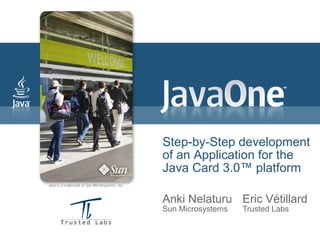

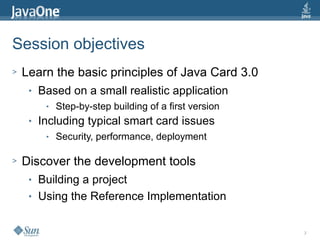
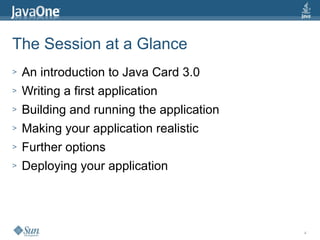



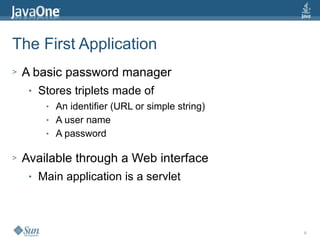
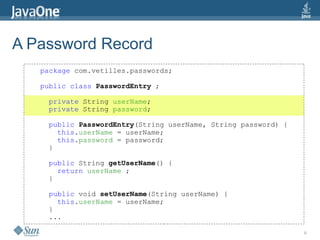




















![30
Secure Storage of Passwords
package com.vetilles.passwords;
import javacard.security.DESKey ;
import javacard.security.KeyBuilder ;
import javacardx.crypto.Cipher ;
import javacardx.crypto.RandomData ;
public class PasswordEntry {
private String userName;
private byte[] password;
private static DESKey theKey ;
private static Cipher cipher ;
public PasswordEntry(String userName, String password) {
if (theKey == null)
initCrypto() ;
this.userName = userName;
setPassword(password);
}](https://image.slidesharecdn.com/javaone2009-151116143709-lva1-app6892/85/Step-by-step-Development-of-an-Application-for-the-Java-Card-Connected-Platform-30-320.jpg)
![31
Secure Storage of Passwords
private static void initCrypto()
{
// Allocates the objects
theKey = (DESKey)KeyBuilder.buildKey(
"DES",KeyBuilder.LENGTH_DES3_2KEY, false);
cipher = Cipher.getInstance("DES_CBC_ISO9797_M2", true);
// Generates a random key value
RandomData rnd = RandomData.getInstance("SECURE_RANDOM");
byte[] value = new byte[16] ;
rnd.generateData(value, (short)0, (short)16);
theKey.setKey(value);
// Clears the key value before to return
rnd.generateData(value, (short)0, (short)16);
}](https://image.slidesharecdn.com/javaone2009-151116143709-lva1-app6892/85/Step-by-step-Development-of-an-Application-for-the-Java-Card-Connected-Platform-31-320.jpg)
![32
Secure Storage of Passwords
public void setPassword(String pass)
{
byte[] bytes = pass.bytes();
password = new byte[bytes.length+9];
cipher.init(theKey,Cipher.MODE_ENCRYPT);
password[0] = (byte)cipher.doFinal(
bytes, (short)0, (short)bytes.length, password, (short)1 );
}
public String getPassword()
{
byte[] bytes = new byte[password.length];
cipher.init(theKey,Cipher.MODE_DECRYPT);
short len = cipher.doFinal(
password, (short)1, password[0], bytes, (short)0 );
return new String(bytes,(short)0,len);
}](https://image.slidesharecdn.com/javaone2009-151116143709-lva1-app6892/85/Step-by-step-Development-of-an-Application-for-the-Java-Card-Connected-Platform-32-320.jpg)



![36
Validating Input
private static final String otherChars = "-_@." ;
private String validateId(String id) throws IOException
{
char[] chars = id.toCharArray() ;
for(char c:chars)
{
if (Character.isDigit(c)) continue;
if (Character.isLowerCase(c)) continue;
if (Character.isUpperCase(c)) continue;
if (otherChars.indexOf(c)!=-1) continue;
throw new IOException("Invalid identifier string");
}
// If we get here, all characters are acceptable
return id ;
}](https://image.slidesharecdn.com/javaone2009-151116143709-lva1-app6892/85/Step-by-step-Development-of-an-Application-for-the-Java-Card-Connected-Platform-36-320.jpg)
![37
Canonicalizing Output
> The idea is to make the output innocuous
● Make sure that characters are not interpreted
● The following only works on ASCII characters
private String encodeUnverifiedString(String str)
{
StringBuffer s = new StringBuffer();
char[] chars = str.toCharArray() ;
for(char c:chars)
{
s.append("<span>#&" + Integer.toString(c) + ";</span>");
}
return s.toString();
}](https://image.slidesharecdn.com/javaone2009-151116143709-lva1-app6892/85/Step-by-step-Development-of-an-Application-for-the-Java-Card-Connected-Platform-37-320.jpg)


![40
Performance Optimization
Persistent memory
private static void initCrypto()
{
// Allocates the objects
theKey = (DESKey)KeyBuilder.buildKey(
"DES",KeyBuilder.LENGTH_DES3_2KEY, false);
cipher = Cipher.getInstance("DES_CBC_ISO9797_M2", true);
// Generates a random key value
RandomData rnd = RandomData.getInstance("SECURE_RANDOM");
byte[] value = new byte[16] ;
rnd.generateData(value, (short)0, (short)16);
theKey.setKey(value);
// Clears the key value before to return
rnd.generateData(value, (short)0, (short)16);
}](https://image.slidesharecdn.com/javaone2009-151116143709-lva1-app6892/85/Step-by-step-Development-of-an-Application-for-the-Java-Card-Connected-Platform-40-320.jpg)
![41
Performance Optimization
Persistent memory
private static void initCrypto()
{
// Allocates the objects
DESKey newKey = (DESKey)KeyBuilder.buildKey(
"DES",KeyBuilder.LENGTH_DES3_2KEY, false);
cipher = Cipher.getInstance("DES_CBC_ISO9797_M2", true);
// Generates a random key value
RandomData rnd = RandomData.getInstance("SECURE_RANDOM");
byte[] value = new byte[16] ;
rnd.generateData(value, (short)0, (short)16);
newKey.setKey(value);
// Clears the key value before to return
rnd.generateData(value, (short)0, (short)16);
// Promotes the key to persistent memory
theKey = newKey ;
}](https://image.slidesharecdn.com/javaone2009-151116143709-lva1-app6892/85/Step-by-step-Development-of-an-Application-for-the-Java-Card-Connected-Platform-41-320.jpg)









